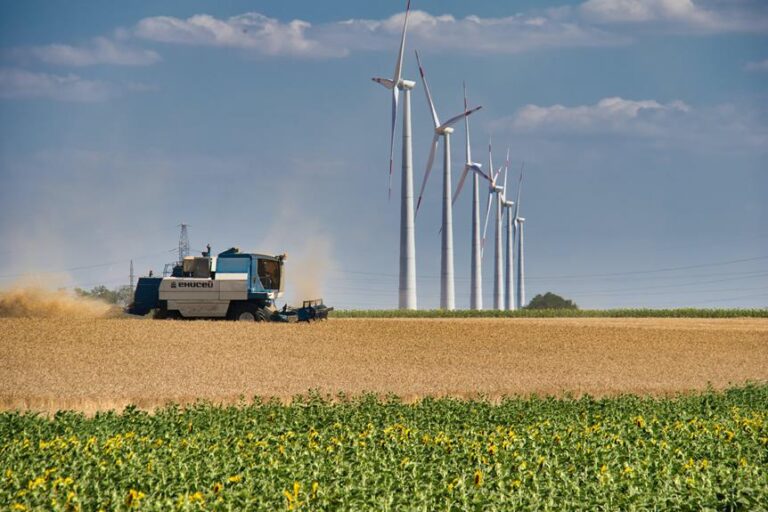8 Best Advantages of Urban Farming in Cities
Are you ready to join us on a journey through the lush urban gardens that thrive in the heart of our cities? Discover the countless advantages of urban farming and unlock a world of fresh produce, cleaner air, and vibrant green spaces.
As we dive into the advantages, let’s explore how these urban oases not only nourish our bodies but also foster a sense of community and belonging. Get ready to be inspired by the power of urban farming in transforming our cities into sustainable havens.
Increased Access to Fresh Produce
One of the best advantages of urban farming in cities is that it allows us to have increased access to fresh produce. With urban farming, we can grow our own fruits, vegetables, and herbs right in our own neighborhoods. This means that we don’t have to rely solely on supermarkets or grocery stores for our fresh produce.
By having urban farms in the city, we can ensure increased food security for our community. We no longer have to worry about food shortages or relying on imports from far away.
Additionally, urban farming helps to reduce food waste. With local farms, we can harvest what we need when we need it, minimizing the amount of food that goes to waste. This not only benefits us, but also the environment by reducing the amount of food that ends up in landfills.
Reduction in Carbon Footprint
When it comes to urban farming, one of the key advantages is the reduction in carbon footprint. By growing food locally in cities, we can significantly decrease the amount of transportation required to bring produce from rural areas to urban centers.
This not only reduces carbon emissions, but also helps to improve air quality by minimizing the use of fuel and reducing traffic congestion.
Environmental Sustainability Benefits
We can achieve a reduction in carbon footprint through urban farming by implementing sustainable practices. Urban farming technologies offer several environmental sustainability benefits that contribute to reducing our carbon footprint:
- Efficient use of resources: Urban farming allows for the efficient use of limited resources such as water and land. By growing food closer to where it’s consumed, we can reduce the energy required for transportation and minimize food waste.
- Decreased greenhouse gas emissions: Urban farms can help reduce greenhouse gas emissions by reducing the need for long-distance transportation and refrigeration. Additionally, urban farms can utilize organic waste for composting, reducing methane emissions from landfills.
- Improved air quality: Urban farming helps improve air quality by absorbing carbon dioxide and releasing oxygen through photosynthesis. It also reduces the need for chemical fertilizers and pesticides, minimizing air pollution.
Improved Air Quality
Urban farming in cities positively impacts air quality and reduces our carbon footprint. Community gardens and urban farms serve as green spaces that help absorb and filter pollutants from the air. Through photosynthesis, plants take in carbon dioxide and release oxygen, helping to reduce air pollution.
Additionally, urban farming reduces the need for long-distance transportation of food, which contributes to greenhouse gas emissions. By growing food locally, we can decrease our reliance on fossil fuels and reduce the carbon footprint associated with food production and distribution.
Improved air quality not only benefits the environment but also has significant health benefits for the community. Breathing cleaner air can reduce the risk of respiratory problems and improve overall well-being.
Urban farming is a sustainable solution that promotes a healthier environment and a stronger sense of belonging within our communities.
Improvement of Air Quality
One of major advantages of urban farming is that it improves air quality through the reduction of pollutants. Urban areas are often plagued with high levels of indoor pollution, which can have detrimental effects on respiratory health. By implementing urban farming practices, we can effectively combat these issues and create a healthier environment for everyone.
Here are three ways in which urban farming contributes to the improvement of air quality:
- Reduction of greenhouse gases: Urban farming helps to decrease the emission of harmful greenhouse gases by absorbing carbon dioxide and releasing oxygen through plant photosynthesis.
- Filtration of air pollutants: Plants act as natural air filters, trapping and removing pollutants such as dust, smoke, and volatile organic compounds from the air.
- Decreased reliance on transportation: Urban farming reduces the need for long-distance transportation of food, which in turn reduces vehicular emissions and air pollution.
Creation of Green Spaces
In implementing urban farming practices, we can transform urban areas into vibrant green spaces. One way to achieve this is through the installation of green roofs, which are covered with vegetation and provide numerous benefits.
Green roofs help to improve air quality by capturing and filtering pollutants, reducing the urban heat island effect, and absorbing rainwater, thus alleviating strain on stormwater systems. Additionally, they provide insulation, reducing energy consumption and costs.
Urban gardening is another effective way to create green spaces in cities. By converting unused spaces such as rooftops, balconies, and vacant lots into productive gardens, we not only beautify the urban landscape but also promote food security, community engagement, and mental well-being.
These green spaces offer a sense of belonging and connection to nature, making our cities more livable and sustainable.
Enhancement of Food Security
When it comes to urban farming, one of the key advantages is the enhancement of food security. By cultivating crops and raising livestock within cities, we can decrease food scarcity and ensure a more reliable and sustainable food supply.
Urban agriculture also provides improved access to fresh produce, reducing the dependence on long-distance transportation and allowing communities to have nutritious food readily available.
Decreased Food Scarcity
We can greatly enhance food security through urban farming, addressing the issue of decreased food scarcity in cities. Urban gardening allows for increased crop yield in a limited space, ensuring a steady supply of fresh produce.
Here are three key advantages of urban farming in combating food scarcity:
- Year-round food production: Urban farming utilizes techniques such as hydroponics and vertical farming, enabling year-round cultivation regardless of climate or season. This ensures a continuous supply of nutritious food, reducing the risk of scarcity.
- Reduced transportation and storage costs: By growing food locally, urban farming eliminates the need for long-distance transportation and expensive storage facilities. This reduces costs associated with food distribution and makes fresh produce more accessible and affordable.
- Community empowerment: Urban farming encourages community involvement and engagement. It empowers individuals to take control of their food sources, fostering a sense of belonging and self-sufficiency. This collective effort strengthens local food security and builds resilient communities.
Urban farming offers a practical solution to decrease food scarcity, ensuring a sustainable and reliable food supply for cities.
Sustainable Urban Agriculture
To what extent can sustainable urban agriculture enhance food security in cities?
Sustainable urban agriculture, including practices such as vertical farming and rooftop gardens, can play a crucial role in enhancing food security in cities. By utilizing innovative farming techniques, urban areas can produce a significant amount of fresh and nutritious food locally, reducing the dependence on external food sources.
Vertical farming, for example, allows for the cultivation of crops in tall structures, maximizing land use efficiency and increasing the overall yield. Rooftop gardens provide additional space for growing vegetables and herbs, making use of underutilized areas in the city.
These practices not only provide access to healthy food options but also promote community engagement and education around sustainable food production. By integrating sustainable urban agriculture into cities, we can create a more resilient and secure food system for all.
Improved Access to Fresh Produce
Sustainable urban agriculture’s contribution to food security in cities can be enhanced through improved access to fresh produce. Urban farming brings numerous benefits that directly impact our nutrition and well-being. Here are three ways it helps improve access to fresh produce:
- Reduced transportation: By growing food within the city, urban farming reduces the need for long-distance transportation. This means that fruits and vegetables can be harvested at their peak ripeness and delivered to local communities quickly, ensuring maximum freshness and nutrition.
- Increased availability: Urban farming enables the cultivation of a wide variety of crops in smaller spaces. This diversity allows for a greater selection of fresh produce, reducing the reliance on imported or processed foods and promoting healthier eating habits.
- Affordability: With local urban farms, the cost of fresh produce can be reduced as there are no transportation or middleman fees involved. This makes nutritious food more accessible to all members of the community, regardless of their income level.
Through improved access to fresh produce, urban farming enhances food security by providing improved nutrition, reducing transportation costs, and making healthy food more affordable for everyone.
Promotion of Local Economy
One of the key advantages of urban farming in cities is the increased economic growth and development within local communities. Urban farming promotes local entrepreneurship by creating opportunities for individuals to start their own businesses and contribute to the local economy. By growing and selling their own produce, urban farmers can establish themselves as entrepreneurs and generate income for themselves and their families.
Additionally, urban farming creates job opportunities within the community. As the demand for locally grown food increases, more hands are needed to cultivate, harvest, process, and distribute the produce. This leads to job creation, reducing unemployment rates and providing residents with a means to support themselves and their families.
Ultimately, urban farming plays a vital role in fostering economic growth and development within local communities.
Mitigation of Food Waste
Urban farming frequently helps us reduce food waste in cities. By growing food locally, we can minimize the amount of produce that goes uneaten and ends up in landfills. Here are three ways that urban farming helps mitigate food waste:
- Reduction in landfill: With urban farming, food is grown and consumed locally, reducing the need for long-distance transportation and storage. This means less spoilage and waste along the supply chain. Additionally, urban farmers often employ sustainable practices such as composting food scraps, further minimizing waste that would end up in landfills.
- Community involvement: Urban farming encourages community participation and engagement. Residents can actively participate in growing and harvesting food, increasing their awareness of the value of food and reducing the likelihood of it going to waste. This sense of involvement fosters a stronger connection to the food system and promotes responsible consumption habits.
- Food sharing initiatives: Urban farming often leads to the creation of community gardens and food sharing initiatives. Excess produce can be shared with neighbors or donated to local food banks, ensuring that it doesn’t go to waste. These initiatives help to address food insecurity while reducing food waste in cities.
Urban farming not only provides fresh, locally grown food but also plays a crucial role in reducing food waste and creating a more sustainable and connected community.
Encouragement of Community Engagement
Engaging the community is a key aspect of urban farming, with active participation fostering a stronger connection to the food system and reducing the likelihood of food waste. Community involvement in urban farming not only provides an opportunity for individuals to learn about sustainable agriculture practices, but it also promotes social integration and a sense of belonging.
By working together to cultivate and harvest crops, community members develop a shared sense of purpose and responsibility. They become invested in the success of the urban farm and the well-being of their neighbors. Moreover, urban farming initiatives often organize community events such as farmers markets and cooking workshops, further encouraging social interaction and fostering a sense of community.
Through community engagement, urban farming transforms cities into vibrant, interconnected communities where people come together to cultivate a sustainable and resilient food system.
Conclusion
Urban farming brings numerous benefits to cities. Not only does it increase access to fresh produce, but it also helps reduce carbon emissions and improve air quality. One interesting statistic is that urban agriculture can reduce a city’s carbon footprint by up to 88%.
By creating green spaces and enhancing food security, urban farming promotes a healthier and more sustainable lifestyle. Additionally, it stimulates the local economy, mitigates food waste, and encourages community engagement. Embracing urban farming is a win-win for cities and their residents.





